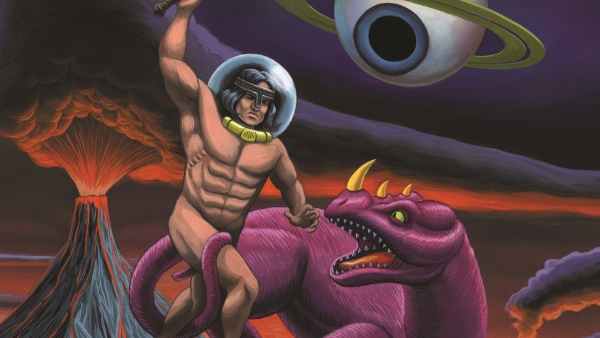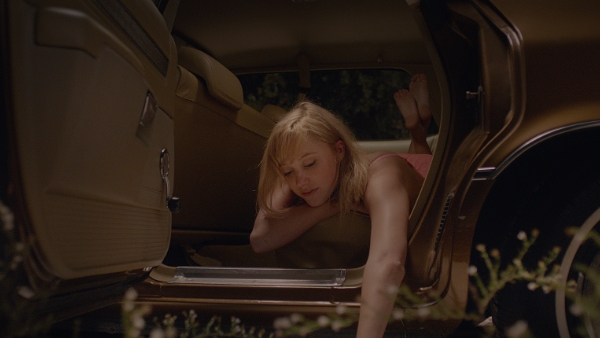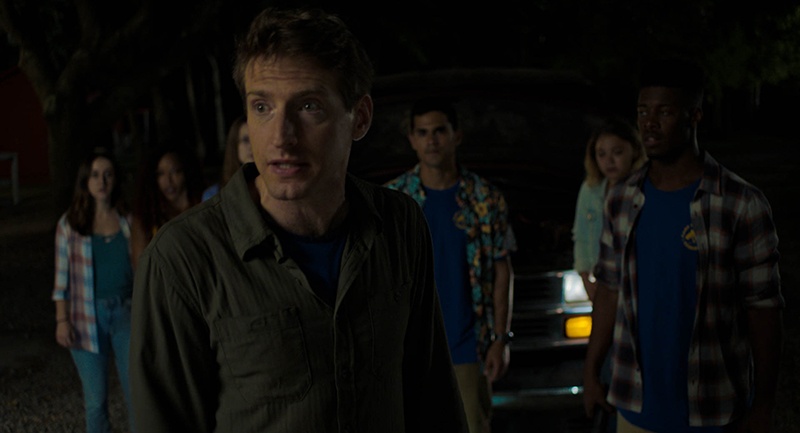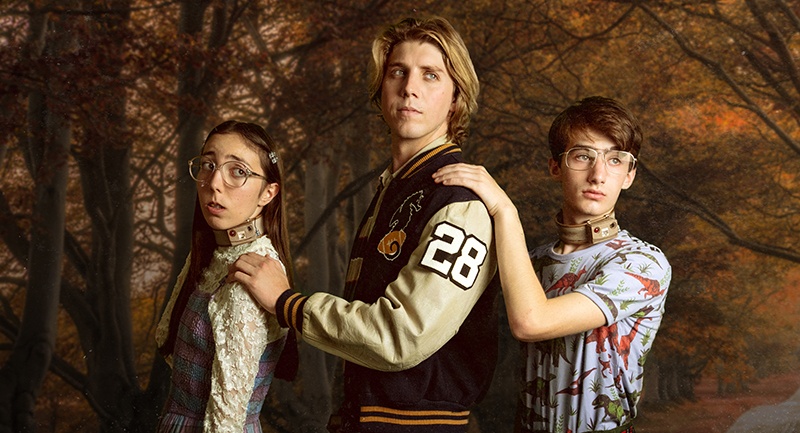
It’s not easy growing up. If it’s not someone telling you what to do and how to do it, there’s plenty of stress we can put on ourselves that are only exacerbated by the insecurities we have trying to “fit in”.
So enter technology to that mix and you can easily identify (or empathize) with Wyrm. Yes, that is his real name, and in Christopher Winterbauer‘s coming-of-age film, the titular character navigates the societal norms as well as the loss of a family member.
In this strangely futuristic yet analog alternate universe, the above pictured lonely, dinosaur-obsessed youth struggles to complete a unique school requirement or risk being held back and enduring a lifetime of embarrassment. We sat with director Christopher Winterbauer and producer Helen Estabrook (Whiplash) to find out all about the characters and world of Wyrm.
GoSeeTalk: Your film was like looking at adolescence through a kaleidoscope. It’s a mix of things I love about the ‘80s, and it was so unique original. Let’s start this off with a very geeky tech question. This was made to look like it was a lost ‘80s property, so did you shoot this 1:1 scale, or 4:3 like VHS format?
Christopher Winterbauer: We shot the film 16 x 9, so it’s not CinemaScope or anamorphic, but that ratio does seem a little compressed. It’s not full 4:3 although I think I talked about that with our DP at one point, but we knew we needed it a little wider for movie screens.
I ask because of what I noticed in the last scene, the memorial scene with the fake rock.
CW: Well, a lot of compositions in the movie are shot wide enough that I feel like you are getting a 1:1 ratio, almost like a picture frame. I understand what you’re saying at the end there. It does feel more vertical heavy than other scenes in the movie or most films do. And that would’ve been the scene for it to be 4:3, honestly.
You mentioned in the intro to the film that this is semi-autobiographical, so do tell: Is it the dinosaurs, the unrequited love, or the fascination with the Internet?
CW: [Laughs] Oh, it’s all of that! [Laughs] It stemmed from the feeling of falling behind or being left behind. That’s a truly universal theme and boys and girls feel that way at a certain age. So I wanted to assign a prop to that feeling which is where the collars came from, but, obviously, the movie is really about all the family dynamics. The film is centered on the death of Dylan, the older brother, and it’s very much based on my family’s inability to talk about sex or death. I come from a very close family, but when it comes to those two subjects, there is no communication. They can’t talk about it, and it’s very difficult for them.
My sisters and I have gotten past it, but is very difficult cross-generational. Now my mother is not exactly the way I depicted Wyrm’s mother in the film. My Mom is very “forward is the direction that we have and we need to go“ and she’s done an incredible job with that in her life. My Dad is definitely the archetypal Midwestern man, although my sisters have made him a much more emotional person across his life. A lot of those character dynamics are from people in my life that I’m closest to, so it’s very autobiographical in that sense. It’s very much the way that Wyrm and Myrcella talk, and the way she imparts wisdom on him in incisive but kind ways. That’s exactly the way my sisters treat me, even though they’re younger than me. [Laughs]
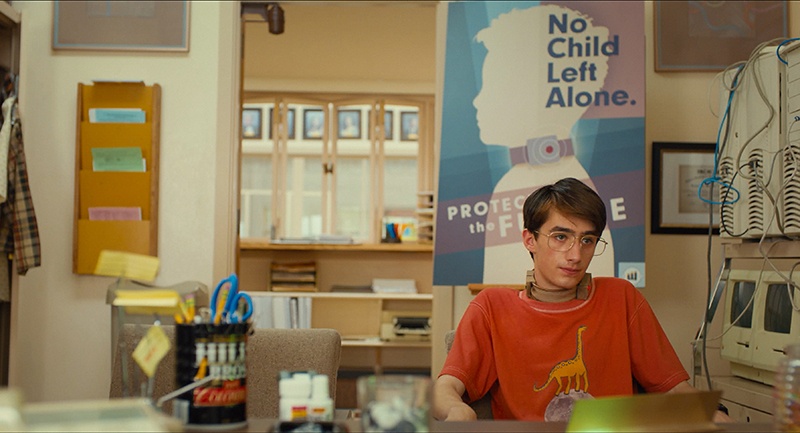
I like how the film played with the idea of absentee parents, in both a literal emotional fashion. What was the decision to make them physically not there?
CW: I shot a short firm version of Wyrm first, and in that one, there were some production reasons why I wanted to keep them out of the picture. But really,with this story, I wanted them out because I really wanted the world to feel grounded in the kids. The minute you introduce parents and responsibility, your perspective comes up to an adult level in a weird way.
I knew I really wanted to stay with the kids, and when I was writing the script, the Uncle Chet character just became another kid trying to figure this all out. So it felt appropriate he would be the adult in the situation. It was almost like a Charlie Brown cartoon where we’re treating the adults like off screen entities.
With the feature, it gave us time to finally meet each of them. I liked that idea that we weren’t even going to see them until we meet them late in the story, even to the point where we had a family portrait that’s just the three kids. Initially I had conceived it with the parents in it as well, but I didn’t even want to reveal who they were until later. Really, it’s just to keep you with these two siblings, and see them in their world, and how removed they are from everything else.
There’s no one offering any good advice, information, or perspective. Wyrm is just getting bad, clichéd advice from other kids, like the idea that women love injuries, and foreign chicks are so sexy. [Laughs] That is exactly the type of things that I would tell my friends, but I would have no idea what I was talking about. [Laughs]
The kids try to present themselves as confident when we all know it’s a front. But these characters are very honest and really pour out their feelings. Azure Brandi plays Myrcella and cries so much in the film. How did you work with them to get these emotions?
CW: I’ll be honest. With Azure, I didn’t have to do anything. She’s the most natural performer I’ve ever seen. There’s a woman in our costume department who is very stern, and doesn’t always have that many positive things to say. She’s great, but she’s a very quiet woman, and she was on set sitting by the monitor one day. After Azure did the scene where she tells Wyrm how much of an asshole Dylan actually was, this woman turns to our costume designer and says, “That girl is going to be a star.” And then she walked off set [Laughs] and that’s the only thing I thing I think I heard her say the entire shoot.
With Azure, we found ourselves dialing it back a little bit because she was so emotive and she could bring it in every single moment, and you wanted to save the punch. There are two big explosions she has: one is where she blows up at Wyrm, and the last scene is just her reacting to him, but her eyes are so big that you can see everything playing out on her face.
Then Theo Taplitz, who plays Wyrm, is such a naturalistic performer. We wanted him to settle into playing a more awkward and stilted element of the dialogue. And Lulu Wilson, who plays Izzy, was the weirdest thing. The character was written a little differently, and when Lulu came in and auditioned, we were blown away. It was a really weird audition. When we saw her we realized she was a much more interesting version of the character then I had originally written. The original girl was generally more mature, and kind of a Braggadocious type, but Lulu gave us this “weird kid trying to be the cool kid kind” of vibe. So my goal was to just try to keep her in the lane that she already brought to the film.
We shot so quickly because we had a lot of pages, and you could only have seven hour shooting days with kids, so that only gave you three or four takes tops. In the scene where Myrcella blows up at Wyrm in the movie, that was the second take. And the last memorial scene, we’re mostly using the first take. They were just so natural with each other. So, I wish I could take more credit. [Laughs] They all read the script, and internalized that themselves. We were very lucky, and we wouldn’t have made our days if they weren’t so tuned in. They were great.
I noticed how much detail went into the collars, and the art direction, even the graphics like the ‘No Child Left Alone’ handbook as well as signs in the background. How much work went into this?
Helen Estabrook: All the graphics you see in the film are Chris’s friend. He even wrote a lot of the copy in the manual and the posters. It’s usually so hard when you are doing movies because you may have somebody who is good at graphics, but doesn’t understand what the world of the movie is, and they only help out a couple days a week, but we were lucky to have this amazing guy, Chris’ friend just knew the world and created all of it, and all the detail. Frankly, it was the best for me, because I didn’t have to worry about it. It would just show up, and it was always perfect. [Laughs] There are so many things in the film that I wish we could showcase that didn’t make it to the film. My favorite is the Jacuzzi sign with a whole list of fake rules.
CW: There’s a poster at the bus stop where Wyrm is waiting, and there are two girls awkwardly kissing. If you look behind him, there is an entire story of a woman named Dawn, who didn’t get her first kiss until late, and she kissed a boy named Ben who became a dentist, and he died and then at the bottom it said “Don’t let our children become widows.” It’s really weird, but he came up with the whole thing. We really didn’t have to give him very much. We just said, “this is the world, go make as many graphics as you possibly can.”
HE: This is a testament to Chris and the world he created not just in the movie, but on set. We had so many people working on this film who just really loved this world and cared for it. So there is so much detail that just makes this all so special.
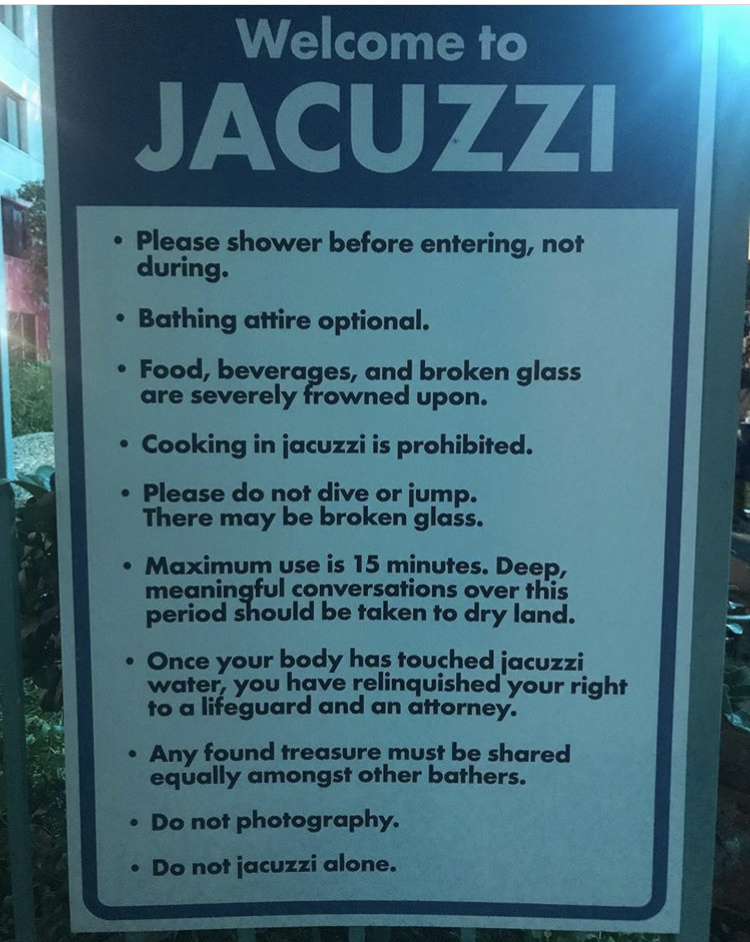
How did you find or source all the ‘80s technology such as the Macintosh disk drives?
HE: Melanie Jones, who is our production designer, had done Whiplash for me. I knew that she and I had done that on a very similar budget to Wyrm. We shot this in LA., and I brought her on because I knew she would have a crew to be able to pull it off since we pulled off Whiplash for the same amount of money. [Laughs] But it certainly wasn’t easy. We didn’t have as much of the props as you think.
We would flip the camera and then move all the computers in one scene to the other angle. It’s one of those movies where you have to tell people, “hey, don’t move the camera an inch to the left or you’ll see that there’s nothing over here.” [Laughs]
What made “Internet” such an important part of the movie?
CW: When I first wrote the short, I was drinking. [Laughs] And I was thinking about what the weirdest version of a coming-of-age story could be. And it just came to me. Internet. It had the same resonance to me as when someone says puberty. A lot like that formative age for all kids, this technological advancement was just over the horizon. I like to think that I created this outsiders version of the story, but this comes from a personal place and here is how it happened.
My parents got a computer in 1995. My grandparents came over, dressed nice, and we had flank steak for dinner or something I thought was fancy. After dinner, my Dad asked, would you like to see the computer now? And everyone got up and walked to the den, and he booted up the computer, and they all got to see it. My grandfather had never seen a personal computer before, and I remember it lighting up in the room and we all had this feeling that “Oh my God, there’s something in this box!” At the time, I knew it as the World Wide Web, but I like the word “Internet” so much better. In terms of the story, it became this thematic catchall for puberty but also this thing that is drawing everybody in, and is supposed to connect us in someway. But really, the movie is about the failure to communicate despite technology.
It’s like “oh, this thing is going to be everything, it’s all encompassing, it’s how you’re going to communicate with everyone.” Blah, blah, blah. But really, all Wyrm needs to do is have conversations with people in his life and that’s what’s actually going to help him at the end of the day.
HE: Since we are in an alternate universe, it helps place us in time. You see the sets, and the set design, and you realize we are not in reality, and we are not in current the current day. We don’t need to know exactly when we are, but we at least know what is happening and where we are in the world. It’s part of a way to situate the world, and you can know not to expect a smart phone to pop up. There are certain questions that are taken off the table immediately by having analog technology as a sort of running gag.
The way that Davey Johnson says the word “Internet” just kills me as well as how the adults type on the keyboard.
CW: That was how Davey improvised the joke and then Natasha Rothwell picked it up. We did takes where they didn’t do that because we were second guessing ourselves as to whether it was too much. But that was just the right amount of tension relief, like “get the hell out of my office.”
HE: This is one of those moments where as a producer you find you don’t know everything. When I first saw it, I thought, that’s too much, we can’t do it. But every single time we’ve screened the movie, it gets one of the biggest laughs. So, I’ll throw my hands up. I don’t know anything. [Laughs]
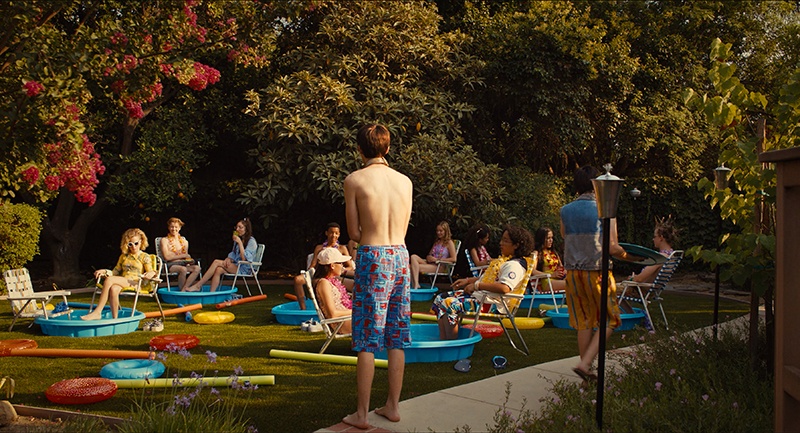
Helen, more to that point, what else have you learned in this process as you helped materialize Christopher’s vision? When do things start to come together in your eyes?
HE: Chris had such a clear vision for this that the minute you got onset you knew that this world would be cohesive and it would work. That was something that was really exciting and one of the reasons I really wanted to do this movie was because Chris knew all the rules of the world, and where we were functioning in it. I think one of the difficulties you face when making a movie like this, or any movie in general, is thinking of the audience’s perspective and asking “What does the audience understand? And what does it matter?”
The difficulty with test screenings is that one of the main questions asked is “What did you understand? What part was confusing, What didn’t you get from this?” But when you actually have an audience watch a movie, there are things they don’t understand and they don’t care. They are getting whatever they need to get from it. They are getting the emotional experience from it.
So, the difficulty is a, trusting your audience will figure out what they need to figure out. The tightrope you walk making a film is not overly explaining something, but not under explaining. That was always the trick with this film. The nice thing about a movie like Wyrm as all you can rely on is what feels right. Am I having the feelings I’m supposed to feel? The only cuts that were made were those that I felt weren’t working because I wasn’t crying at the end. Watching this again yesterday, I cried at the end. So I was like “OK, we’re good!“
The scene towards the end, in the van, where you find out what really happened to the Dylan is very emotional. Then, at the end, none of the interviews Wyrm conducted for the memorial were censored. People we heard exactly how they felt. He allowed people to, more or less, speak for themselves. And that was very heartfelt even if it was raw and unexpected.
CW: I hope the support, and praise for the film at a festival like Fantastic Fest, proves that there is an audience for this movie which marches to the beat of its own drum. But like you said, it very much wears his heart on his sleeve. I think that what makes me optimistic for a movie like this is that there is a lot of material out there that it pretty pessimistic. We live in a pretty cynical time, so even though a lot of the humor in this movie could come at the expense of the characters early on, every character is trying to figure out what to do in the week of this tragedy. So it is a very optimistic conclusion to the film, and I think that it sends the message that communication is the key to figure anything out.
Wyrm is currently seeking distribution. We’ll keep you updated with any news we get as well as the first word of a trailer.
